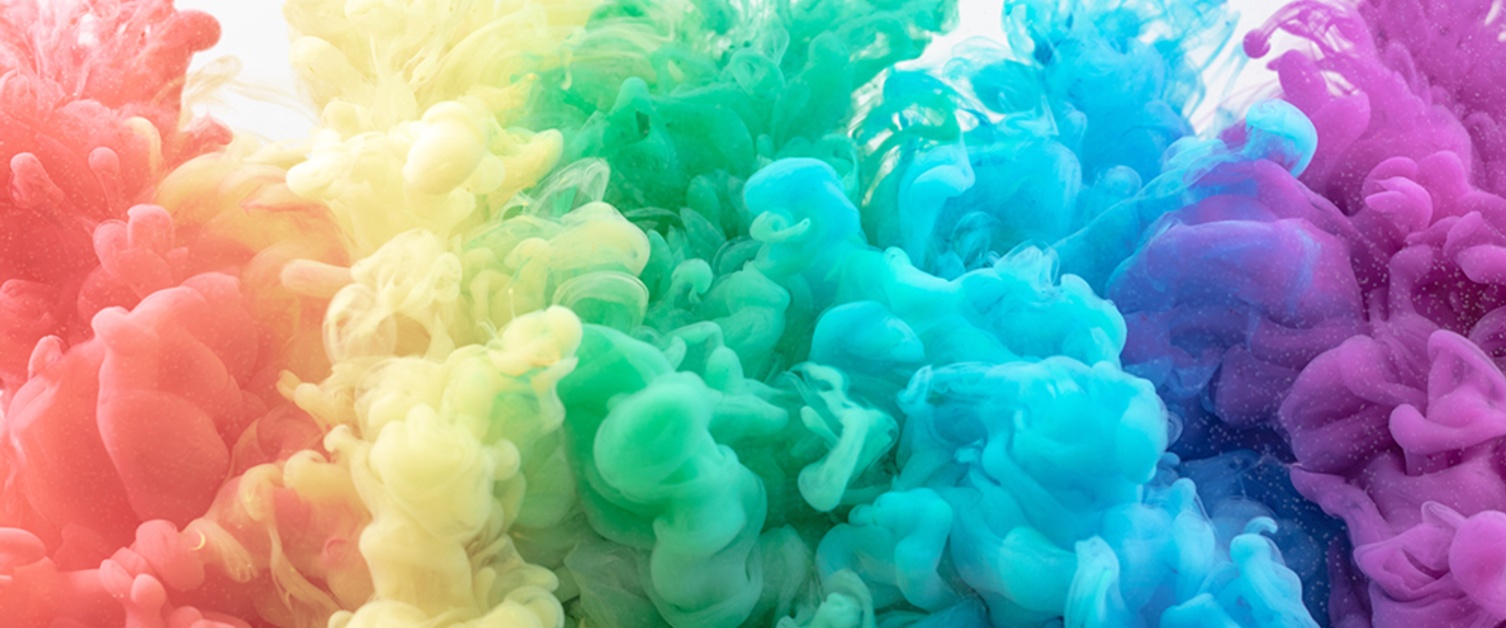All the Colors of the Sky: Decoding Rainbows, Halos, and Coronas
- By Gunther Können
- Jul 1, 2021
What do you see when you look up?
Clues to the state of the atmosphere are all around us if we know how and where to look. The rainbow is probably one of the best known signs as its brilliant colors and dramatic appearance make it hard to miss. But there’s more to rainbows than you might guess. If a halo or rainbow is observed in the sky, it is carrying information about the shapes, sizes, and/or composition of airborne particles. Each rainbow and rainbow-esque phenomenon carries its own specific information about the particles that generate it. This information is sometimes difficult to obtain from other sources.
The streaks of color may not last long, and they occur at unpredictable times. But in cases where the actual state of the atmosphere at a certain moment is of importance, or when one is interested in knowing the composition of particles floating in the air, their observation may help. So remember that every time you see and photograph a rainbow, you’re making important observations about the world around you.
Rainbow Basics: What Makes a Rainbow?
Rainbows are created when the sun shines through water droplets and the light spectrum is split apart into all its colors and reflected out into the atmosphere. In order to see a rainbow, there must be water droplets present in the air and the rainbow will appear at a 45° angle centered on the antisolar point - that is the point that is directly opposite the sun from the viewer’s perspective (i.e. where your shadow is). The sun must be behind the viewer's head.
What Can Rainbows Tell Us?
Besides its colors, the chief characteristic of a rainbow is its roundness, which comes from the spherical drops that are reflecting light. So the presence of a rainbow tells us that there are spherical particles present in the sky: water drops, of course. When a drop is flattened, its primary rainbow is flattened as well. Large falling drops are flattened by aerodynamic forces and as a result so is the rainbow in heavy showers. For a low-sun rainbow, its distance to the antisolar point is about 1° smaller at its top than at its sides.
The primary rainbow is generated by a light path through a drop that consists of entry–reflection–exit. An additional internal reflection creates another rainbow, called the secondary rainbow. That rainbow appears a few degrees outside the primary one and is recognizable by its reversed color sequence (Fig. 1). There will be an 8°-wide region between the two rainbows that is in the darkest part of the sky. The secondary rainbow always accompanies the 8-times-brighter primary one, but because it is often quite dim, it can remain unnoticed.
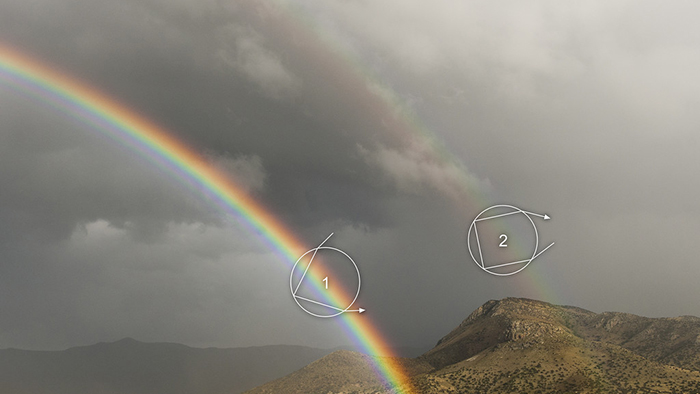
Fig. 1: Primary and secondary rainbows in a rain shower over New Mexico (NM). The color sequence of the bows is reversed; the sky is darkest between the bows. The reversed colors of the secondary rainbow arise because the emerging light rays cross the incoming light rays. Because of the flattened shape of the falling drops, the primary rainbow is slightly flattened in heavy showers. The diagrams (labeled 1 and 2) indicate the ray paths through the drop that form the primary and secondary rainbows. Photograph taken by H. E. Edens in Magdalena, NM, on 22 Sep 2013. Solar elevation is 17.6°.
The primary and secondary rainbows contain much the same physical information. One difference is that the secondary rainbow is always perfectly circular. Its position in the sky is not impacted by the flattening that occurs for large falling drops. Thus, in contrast to the primary rainbow, the top of the secondary rainbow contains no information about whether the falling drops are spherical or not.
The angle of the rainbow can also reveal information about the type of water drops that are creating the rainbow. Seawater, since it has a higher refractive index than freshwater, shifts the rainbow in the direction of the antisolar point. Scrutinizing the rainbow shift in Fig. 2 as a function of wavelength could reveal that seawater contains salt (NaCl). Obviously, there exists a more direct method to find out that seawater is salty. But rainbows can provide information on planets other than Earth! In the early 1970s the research team of Hansen and Hovenier (1974) recognized a prominent rainbow peak in the polarization of Venus and analyzed its properties and its shift relative to a freshwater rainbow. From this they concluded that the Venus upper clouds consist of drops with sizes on the order of microns, and that these drops would taste somewhat sour rather than salty because they very likely consist of concentrated sulfuric acid. In the late 1970s this conclusion was beautifully confirmed by in situ measurements of descending space probes.

Fig. 2: The rainbow in freshwater raindrops is extended below the horizon by a rainbow in seawater spray. The slightly larger refractive index of saltwater drops causes the radius of the subhorizon rainbow to be 0.8° less than that of the above-horizon freshwater rainbow. Photograph taken by J. Dijkema in the Pacific Ocean, 800 km southeast of Japan, during 1981. Solar elevation is 32.5°
Expanding the Rainbow Family
Primary and secondary rainbows are well documented. But in addition to those bows, light that has undergone three internal reflections during its path through a drop makes a third rainbow, four reflections a fourth rainbow, and so on. These “high-order rainbows” become increasingly weaker. Just like the primary and secondary rainbows, the third and fourth rainbows are close together (separated by about 6°) and have their red sides facing each other. However, this duo appears on the bright side of the sky, 45° from the sun. The fifth rainbow is located in the region opposite the sun again, not far from the primary and secondary rainbows.
Although there are no preexisting reasons that prevent the observation of the third rainbow in nature, it was only recently that it was unambiguously detected. Before 1700 observers searched in the wrong part of the sky, and since then only a handful of possible sightings of the third rainbow have been reported, most of them being of dubious quality. This changed dramatically in 2011 when Michael Grossman decided to take “in the blind” pictures in the correct direction, and after some image processing, the long-searched-for third rainbow was found!
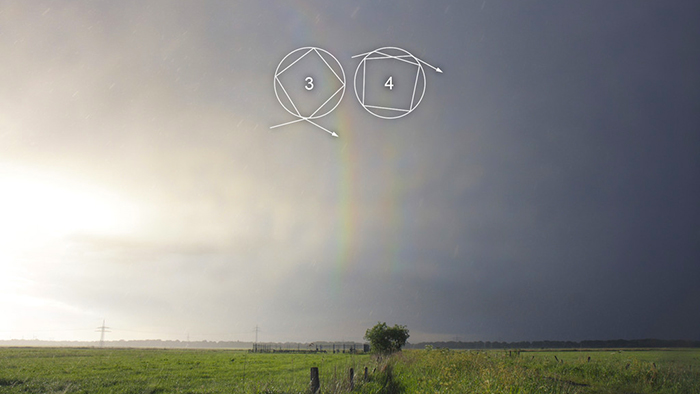
Fig. 3: First picture ever of the fourth rainbow and second picture ever of the third rainbow. This pair of high-order rainbows appears on the sun side of the sky and is made visible by contrast enhancement. As in the case of the primary and secondary rainbows, the third and fourth rainbows have their red sides toward each other. However, the spacing between them is decreased. The diagrams (labeled 3 and 4) indicate the ray paths through the drop that form the third and fourth rainbows. Photograph taken by M. Theusner in Schiffdorf, Germany, on Jun 2011. Solar elevation is 10.9°
One month later, in an attempt to reproduce this successful observation, Michael Theusner obtained a picture containing both the third and fourth rainbows. In 2012 Harald Edens photographed the fifth, and in 2014 he found traces in his earlier pictures of what could be the seventh rainbow. Since then, more pictures of high-order rainbows have become known. Figure 3 shows the iconic picture of the third and fourth rainbows by Theusner; Figure 4 shows the discovery picture with the green and blue hues of the fifth rainbow—its red being hidden behind the much brighter secondary rainbow.
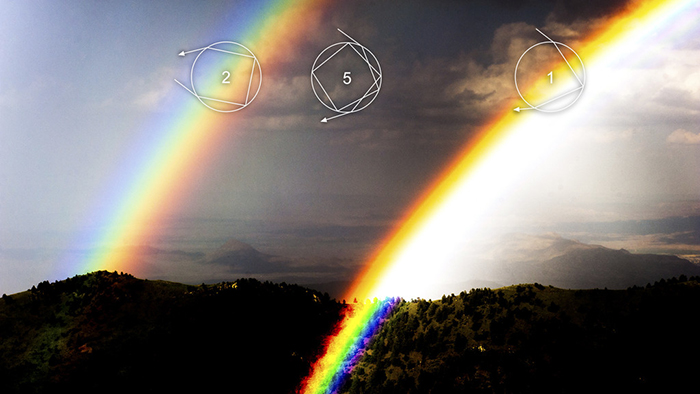
Fig. 4: First picture ever of the fifth rainbow. The green and blue hues between the primary and secondary rainbows are from the (broad) fifth rainbow whose red component is hidden by the much brighter secondary rainbow. The picture is contrast enhanced. The diagrams (labeled 1, 2, and 5) indicate the ray paths through the drop that form the primary, secondary, and fifth rainbows. Photograph taken by H. E. Edens at Langmuir Laboratory, NM, on 8 Aug 2012. Solar elevation is 26.4°
Going Over the Rainbow
Atmospheric Halos
Halos not only exist in the form of colored circles around the sun, but can also appear as arcs, spots, streaks, loops, and circles at various locations of the celestial sphere, a consequence of the faceted nature of crystals. Simple isolated halos occur frequently in the sky: in the midlatitudes, a well-trained observer may see a halo or a trace of it typically five to seven times per month, but for others often halos remain unnoticed because of their proximity to the sun. Sunglasses help to improve one’s observational record.
So what do halos tell us? The presence of halos indicates that polyhedral solid particles are present in the atmosphere, that is to say, there are ice crystals in the air. Any pair of crystal faces may act as a refracting prism, generating colored phenomena concentrated on the sun side of the sky. If the crystals are randomly oriented, the halos appear as concentric circles centered on the sun. The size of the circles will depend on the type of crystal and the angle between the faces within it. However, many of the ice crystals prefer a certain, non-random orientation in the air, which results in the appearance of a large variety of colored or white halo structures—many of them being positioned near the circular halo to which they are associated and others occurring at other locations on the celestial sphere.
For the most part, the ice crystals that form halos have a hexagonal shape and are plates or columns with flat ends. This usually results in halos grouped at 22° and 46° from the sun, respectively. Figure 5 shows a well-developed halo display with circular halos as well as halo arcs. The arrangement of the halo arcs around the circular halos is not random but represents a mapping of the crystal symmetry onto the sky; for example, the sixfold symmetry in the arrangement of the arcs associated with the 46° circular halo in Fig. 5 is an expression of the sixfold symmetry of ice crystals.
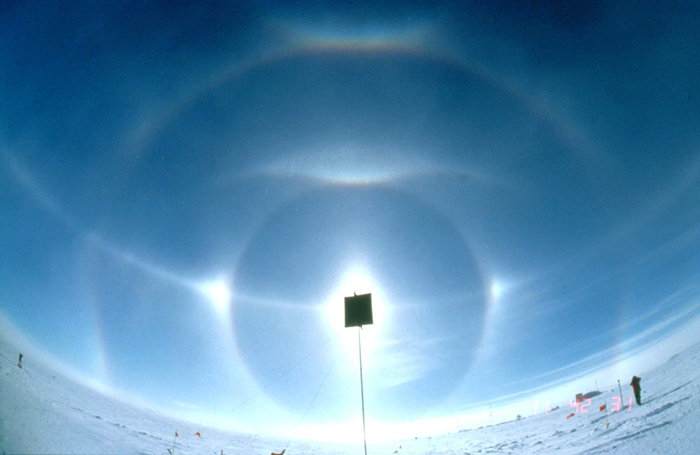
Fig. 5: This rich halo display is due to simple hexagonal ice crystals with flat ends, floating in various modes of orientation. The two circular halos are due to crystals having random orientations and have radii of 22° and 46°, respectively. Associated with these circular halos are arcs caused by the same crystals in the swarm, but now preferentially oriented. The spots to the right and left of the sun are the 22° parhelia (“sundogs”). Photograph taken by G. P. Können at U.S. Amundsen–Scott South Pole Station (90°S) on 1 Jan 1998. Solar elevation is 23.0°.
Sometimes terrestrial halos originate from ice crystals with pyramidal instead of flat faces at their ends, which results in a different and often more complicated halo display (Fig. 6). To many people, the shapes of crystals bear a certain beauty. Great halo displays are celestial manifestations of this crystalline beauty.
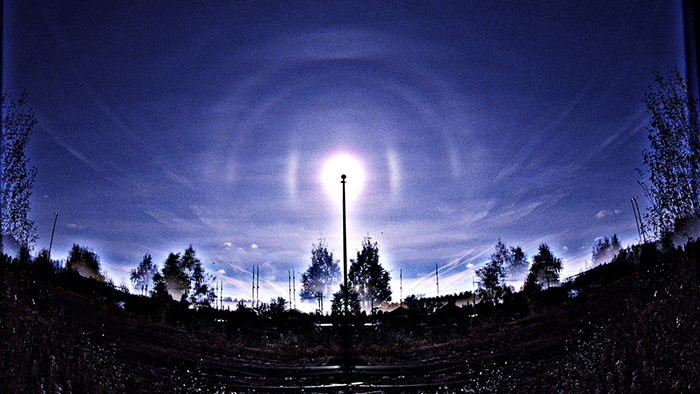
Fig. 6: This halo display is caused by hexagonal ice crystals having pyramidal rather than flat ends. The presence of these crystals manifests itself by the appearance of multiple circular halos with radii between 18° and 24° and the appearance of strange-shaped halo arcs at unusual places. The sun is hidden behind a nearby object. This stacked picture is contrast enhanced. Photograph taken by M. Riikonen at Oulu, Finland, around noon on 17 Sep 2001. Solar elevation is 27°.
Halos contain a lot of information. Their shape and position will provide insight into the shape and composition of the ice crystal, how light reflects through it (and therefore the chemical composition of it); the symmetry and shape of the crystal; and how the falling crystals are oriented in the air. From the features appearing in a halo display a model of the halo-making crystals can be constructed. The richer the halo display is, the more unique the reconstruction. Although the terrestrial halo makers are nowadays well understood, surprises can still occur. In 1997 the appearance of an atypical halo display proved the presence in the atmosphere of preferentially oriented ice crystals with exotic pyramidal faces—a type of ice crystal that had not been detected before in the free atmosphere.
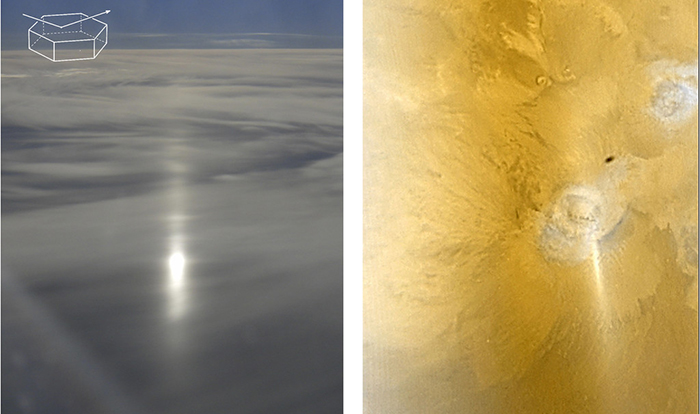
Fig. 7: (left) Halo in the terrestrial atmosphere. (right) Halo in the thin clouds of Mars. The white streak in the pictures is the so-called subsun, a halo that appears as an elongated mirror image of the sun in the clouds. It is due to the reflection of sunlight by horizontally oriented crystal faces. The picture of the terrestrial subsun is taken from an aircraft; its length (∼4°) indicates a mean tilt angle of 1° of the reflecting crystal faces. The Mars picture is taken by a NASA/JPL scanning platform, causing the Martian subsun to be strongly elongated. Left photograph taken by M. Vollmer on 9 Aug 2013. Solar elevation is ∼10°.
Halos are expected to occur in the atmospheres of other planets as well. A bright subhorizon halo streak has indeed been observed on Mars by an orbiting space probe (Fig. 7), but that type of halo is due to external reflection at the crystal faces, and so contains only information about the degree of preferential orientation of the halo-generating airborne Martian crystals, not about the composition of these crystals. In 2005, during the descent of the Huygens probe through the dense atmosphere of Saturn’s moon Titan, we were eager to look for halos from methane crystals, but nothing showed up in the images. In fact, at a height of 21 km above the surface, the probe passed through a swarm of particles that were most likely methane crystals, but at that stage of the descent, the sky above the probe was overcast. Hopefully, on another occasion the Titan weather will be more cooperative.
Diffraction Coronas
The diffraction corona is in its simplest form a white aureole, with angular diameter of a few degrees, surrounding a light source and terminating in a reddish outer edge (Fig. 8). Sometimes it is surrounded by additional colored rings. The diffraction corona occurs a couple of times during virtually every partially cloudy day. Many people are familiar with the diffraction corona surrounding the moon but are unaware of its brilliant counterpart surrounding the sun, as one instinctively avoids looking in the close vicinity of the sun. However, with the aid of sunglasses and by blocking the solar disk with one’s thumb, one can see the fine color hues of the sunlight-induced diffraction corona in their full richness.

Fig. 8: Typical diffraction corona around a gibbous moon, during morning twilight. Photograph taken by C. Hinz from the mountain Wendelstein (1835 m) in the Bavarian Alps on 22 Jan 2011. Solar elevation is −3.0°.
The corona is caused by diffraction of light by micron-sized cloud particles, in most cases water drops. As is the case for rainbows, the roundness of the diffraction corona shows how spherical the drops are. The diameter of the diffraction corona is inversely proportional to the drop size, so the corona expands where it extends over the smaller drops at the edge of a cloud. Noncircular coronas exist, but these small-sized phenomena are actually caused by pollen instead of by deformed drops.
Glories
The corona has its counterpart on the opposite side of the sky. This phenomenon is called the anticorona or the glory. Its shape resembles the diffraction corona, consisting of a white central area with angular diameter of a few degrees surrounded by a reddish ring, but now the center is at the shadow point (Fig. 9). Sometimes a second or even a third concentric ring is present.

Fig. 9: Typical appearance of a glory as seen from an aircraft. The glory is centered on the shadow of the plane or, better, on the shadow of the camera that took this picture. The distance of the glory’s center below the horizon indicates a solar elevation of 13.5°. Photograph taken by P. Laven on 30 Mar 2005.
The glory is caused by backscattering of light by small drops via a mechanism different than that of the diffraction corona. Given the many sightings reported by pilots, it is probably as common as the diffraction corona, but ground-based observers rarely see it.
The diameter of the glory is inversely proportional to the drop size. Noncircular glories regularly occur, but they are the result of gradients in the droplet sizes in the cloud deck where the glory appears, rather than being an indication of nonsphericity of the tiny drops (Fig. 11).
The presence of a glory implies that spherical particles of a certain size are present at the site of its appearance. These spheres have to be transparent in order to create a glory, but unlike other phenomena, the structure and diameter of a glory does not contain any useful information about the chemical composition of the glory-making particles.
The mechanism causing the glory had remained a mystery for a long time: it was only in 1947 that Van de Hulst formulated the first reasonable model of the formation of this enigmatic phenomenon. However, it took another half century until the glory was fully understood —a clear illustration of the fact that the development and evolution of atmospheric optics is still in progress.
Glories in the terrestrial atmosphere have been observed from space and recently also in the atmosphere of Venus. As our exploration of the solar system is still at its very early stage and research on exoplanets is booming, the detection of glories, halos, or rainbows in the atmospheres of planets other than Earth, Venus, or Mars, or even perhaps in the atmosphere of an Earth-like exoplanet, seems to be just a matter of time.
This article has been edited and adapted specifically for the AMS Weather Band from a longer article that appeared in the Bulletin of the American Meteorological Society. Any errors or omissions may be attributed to AMS staff. Copyright remains with the AMS.
